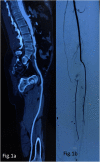Management of Acute Limb Ischaemia Due to COVID-19 Induced Arterial Thrombosis: A Multi-Centre Indian Experience
- PMID: 35860829
- PMCID: PMC9257383
- DOI: 10.3400/avd.oa.22-00012
Management of Acute Limb Ischaemia Due to COVID-19 Induced Arterial Thrombosis: A Multi-Centre Indian Experience
Abstract
Objective: To determine the outcomes following various surgical and medical treatments of Coronavirus disease 2019 (COVID-19) induced acute limb ischaemia. Methods: A retrospective study of patients presenting with COVID induced arterial ischaemia in three hospitals from Southern India during the months of May 2020 to August 2021 was undertaken. These patients were managed by either thrombectomy, primary bypass, thrombolysis, anticoagulation or primary amputation based on the stage of ischaemia and the severity of COVID. Results: A total of 67 limbs in 59 patients were analysed. The average time to intervention was 15 days. Upper limb involvement was seen in 16 and lower limb in 51 limbs. Of the 67 limbs, 39 (58.2%) were treated by open surgical revascularisation, 5 (7.4%) by catheter directed lysis, 17 (25.3%) were managed conservatively and 6 (8.9%) underwent primary amputation. Successful revascularisation could be carried out in 88.6% of patients. A limb salvage rate of 80.6% was achieved in these patients with a re-intervention rate of 13.6%. Major amputation rate was 14.92% and mortality was 13.56%. Conclusion: Limb ischaemia after COVID can be safely managed by open thrombectomy or bypass. Similar rates of limb salvage as in non-COVID acute limb ischaemia can be obtained.
Keywords: COVID-19; acute limb ischaemia; arterial thrombosis.
© 2022 The Editorial Committee of Annals of Vascular Diseases.
Conflict of interest statement
Declaration of Conflict of InterestsNo potential conflicts of interest among any of the authors with respect to the research, authorship, and/or publication of this article. This research did not receive any specific grant from funding agencies in the public, commercial, or not-for-profit sectors.
Figures



